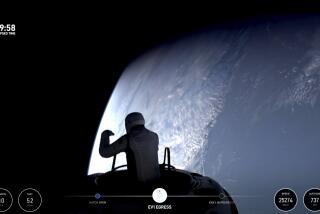Space ship blasts through sound barrier, reaches new heights in test
British billionaire Richard Branson’s commercial space venture Virgin Galactic took one step closer to carrying tourists into space with its latest supersonic test flight.
On Thursday, the company’s rocket plane went Mach 1.43 in the skies above the Mojave Desert. It is the second time the aircraft, named SpaceShipTwo, has broken the sound barrier.
The test flight is a key milestone in Virgin Galactic’s effort to be the world’s first commercial space liner, which would make several trips a day carrying scores of paying customers into space for a brief journey.
“This is a giant step,” Branson wrote in a blog post. “Our spaceship is now the highest commercial winged vehicle in history!”
During the test, SpaceShipTwo was taken to about 46,000 feet by a carrier aircraft, and nearly one hour into the flight, it was dropped like a bomb.
After a short free fall, pilot Mark Stucky and co-pilot Clint Nichols engaged the hybrid rocket motor -- powered by nitrous oxide and a rubber compound -- for 20 seconds.
SpaceShipTwo blasted to Mach 1.43, reaching about 56,000 feet in altitude.
The rocket plane flew solo for nearly 30 minutes, making a smooth landing in Mojave about 9:25 a.m.
The flight began on a desert runway at Mojave Air and Space Port, about 100 miles northeast of Los Angeles. Mojave is where the aircraft was designed and built.
Another key milestone achieved during the test was that the aircraft deployed its twin tail sections to a “feathered” position, which is designed to slow the aircraft’s descent and allow it to softly return to Earth.
The one-of-a-kind design is vital to reducing wear and tear on the six-person rocket ship, so it can eventually make several commercial trips each day into outer space.
It’s a novel approach. Until now, astronauts have reached space packed tight in a capsule or shuttle attached to a high-powered rocket.
Instead, Virgin Galactic will use a WhiteKnightTwo carrier aircraft that will fly with the reusable SpaceShipTwo rocket plane under its wing to 50,000 feet, where the spaceship will separate and blast off.
When the rocket motor engages, it will power the spaceship to nearly 2,500 miles per hour and take the pilots -- and up to six passengers -- to the edge of space, more than 60 miles above the Earth’s surface.
Once they reach that suborbital altitude, passengers will experience weightlessness and see the curvature of the Earth. Then they will reenter the atmosphere and glide back to the runway.
The price for the experience: $250,000.
Virgin Galactic said it has accepted more than $80 million in deposits from about 630 reservations made by people who are interested in the ride.
The WhiteKnightTwo carrier aircraft, which resembles a flying catamaran because it has two fuselages, and SpaceShipTwo are still in the midst of the test-flight program, which will continue in Mojave until Virgin Galactic believes it can begin commercial operations.
Virgin Galactic hopes to reach space in test flight this year and make its first passenger flight sometime in 2014 from Spaceport America in New Mexico, where the company hopes to eventually offer the tourist trips.
Branson first hoped he would blast tourists into space by 2007, but the date has repeatedly slipped. Space experts wonder whether even 2014 is too ambitious. Virgin Galactic still needs to clear regulatory hurdles, particularly satisfying safety concerns with the Federal Aviation Administration.
ALSO:
Upgrades aim to extend B-52 bombers’ already long lives
Watch F-35 fighter come in for its first nighttime vertical landing
Entrepreneur is ready to prove his zeppelin idea is more than hot air
More to Read
Inside the business of entertainment
The Wide Shot brings you news, analysis and insights on everything from streaming wars to production — and what it all means for the future.
You may occasionally receive promotional content from the Los Angeles Times.











